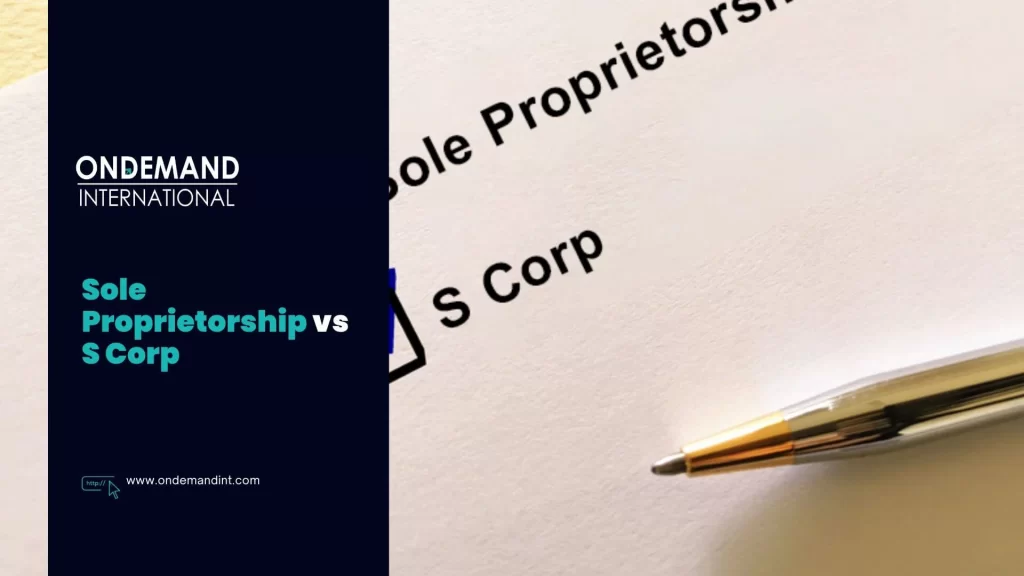Sole Proprietorship vs S Corp
In the diverse landscape of business structures in the United States, two distinct structures, Sole Proprietorship, and S Corporation, offer entrepreneurs varying approaches to establishing and managing their ventures. Each model comes with its own set of advantages, disadvantages, and legal implications that can significantly influence the way a business operates and grows.

In this article, we will cover the the core characteristics of Sole Proprietorship vs S Corp, shedding light on their key differences and helping aspiring business owners make informed decisions about the structure that best aligns with their goals.
Meaning of Sole Proprietorship
If you are looking to set up a company in the USA, the most straightforward type of corporate structure is a sole proprietorship. In this form of structure, a single person owns and runs the organization, making all decisions and taking full responsibility for the financial obligations and assets of the corporation. Even though they are simple to set up, sole proprietorships do not have a legal distinction between the individual and the company.
Meaning of S Corporation
According to IRS regulations, businesses that function as S corporations can have either a limited liability company (LLC) or a C corporation as their legal form of corporate organization. This implies that acquiring an S corporation designation for a sole proprietorship requires incorporation as an LLC or C corp.
Liability and Legal Structure
- Sole Proprietorship: The owner is personally responsible for all the liabilities of the corporation. There is no formal distinction between the proprietor and the company, exposing personal assets to potential risks.
- S Corporation: Shareholders possess limited liability, and their personal assets are typically shielded from commercial debts. The corporation’s separate legal identity shields shareholders from personal responsibility.
Taxation
- Sole Proprietorship: Gains and losses are disclosed on the proprietor’s individual tax return. There is no separation of personal from commercial revenue.
- S Corporation: S corporations enjoy pass-through taxation, where gains and losses are passed through to stockholders’ individual tax returns. This can lead to potential tax savings, as the corporation itself is not liable for federal income taxation.
Ownership and Formalities
- Sole Proprietorship: The proprietor of the company maintains complete authority over it and makes every decision. No formal documentation or filings are required to establish a sole proprietorship.
- S Corporation: Ownership is divided among shareholders. Formalities that companies must follow include producing yearly reports, keeping corporate documents, and organizing annual meetings.
Formation and Complexity
- Sole Proprietorship: Establishing a sole proprietorship is straightforward and typically involves no formal filing requirements. You may nevertheless be required to acquire local licenses and authorization.
- S Corporation: Forming an S corporation involves more complexity, including submitting articles of incorporation with the state and choosing S corporation status with the IRS. Compliance with ongoing formalities is also essential.
Considerations for Choosing the Best Form of Business
Business Size
Sole proprietorships are suitable for small businesses with a single owner, while S corporations are more suitable for businesses with multiple shareholders.
Liability Concerns
If personal liability protection is a priority, an S corporation might be the better choice.
Tax Implications
Consider the potential tax advantages of an S corporation, especially if your business generates significant profits.
Operational Complexity
Sole proprietorships are less complex to operate, making them ideal for solo entrepreneurs. S corporations require more formalities and administrative tasks.
Growth and Funding
If you want to get external funding or attract investors, an S corporation structure can offer credibility and flexibility.
Comparison of Sole Proprietorship vs. S Corporation
| Aspect | Sole Proprietorship | S Corporation |
| Liability | Unlimited personal liability. Owner’s assets at risk. | Limited liability. Shareholders’ assets are protected. |
| Taxation | The owner reports profits/losses on a personal tax return. | Profits/losses pass through to shareholders’ personal taxes. |
| Ownership | Single owner with full control. | Multiple shareholders with shared ownership and governance. |
| Legal Formalities | Simple establishment; no formal filing requirements. | Articles of incorporation, formal meetings, annual reporting. |
| Business Size | Typically small businesses with a single owner. | Suitable for businesses with multiple shareholders. |
| Operational Complexity | Less complex; and ideal for solo entrepreneurs. | More complex; and involves formalities and administrative tasks. |
| Growth Potential | Limited growth potential due to size and structure. | Credibility, flexibility, and growth potential with shareholders. |
| Funding | Limited access to external funding and investors. | Potential to attract investors and raise capital. |
Conclusion
Selecting between a sole proprietorship and an S corporation requires careful consideration of liability, taxation, ownership, and operational factors. You may make an informed choice that establishes the basis for the success of your firm by comprehending the distinctions between these two business structures and evaluating the particular requirements of your particular operation.
Explore the expertise of our business formation specialists at OnDemand International for guidance on registering a sole proprietorship or an S Corporation. Our experienced consultants are committed to helping you develop a business structure that precisely satisfies your particular needs and objectives.
FAQ’s
Yes, you can convert your sole proprietorship to an S corporation by meeting the eligibility criteria and filing the necessary paperwork.
Yes, an S corporation can have a single shareholder, but it can also have multiple shareholders.
S corporation shareholders can receive distributions that are similar to dividends, but they’re generally not subject to self-employment taxes.
You can transition from being a sole proprietorship to a S corporation or the other way around. However, there can be legal and tax implications for the process.
CEIDG is a business book of entries with info on self-employed entrepreneurs. Any sole trader must register in CEIDG.

